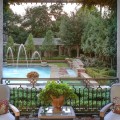Garden Trellis
A garden trellis is a landscape element created by interlocking vertical, horizontal, and diagonal bars into a structure that either accents a larger vertical surface or exists as a freestanding form.
Garden plants are then trained to climb up the bars and cover the surface with greenery. This adds dramatic vertical impact to architecture, hardscape design, and landscaping as a whole.
Garden trellises can be designed in any number of shapes.
The one most commonly envisioned by the average person is the style that stands adjacent to a brick wall. It consists of two vertical sides of equal height and one or more arches that form the top lateral support.
Free standing structures are often constructed with a lateral top support with no arch or dip. This creates a rectangular form that which, when later covered in plant life, may even provide a measure shade for a small garden bench. A smaller, highly decorative design is one called an obelisk trellis. This design consists of ascending circular rings that provide support for vertical bars that converge into a point at the top.
Countless derivatives of these basic designs can be developed to meet the specific needs of the landscape master plan.
A garden trellis can be made from either wrought iron or wood.
Both have equal value based upon the landscape design they are intended to support and the landscape elements in their immediate proximity. Generally speaking, wrought iron is used to support more formal, Old World, or European style landscapes. It also provides an exceptional aesthetic compliment to stone and brick masonry. In fact, it can even be used as a compliment to concrete hardscapes, either plain or decorative.
Wood has a much more organic feel to it and works better with free standing garden trellises on properties that strive to deliberately emulate nature as much as possible.
Wood in its natural color creates a very soft, basic touch. Stained or painted wood is used to compliment colors found in gardens or landscape architectural elements.
A less formal and more Americana touch, if you want to use that term, can be created with a wooden trellis. Wood can be left in its natural state for a very basic appearance, or it can be stained or painted to compliment the colors of a home and the flowering plants that surround the house.
One of the best things about garden trellises is the many opportunities that they offer for location.
They can be erected in any place where vertical impact adds appeal to hardscape or garden design. Trellises are commonly built along the sides of patios, near the walls of houses, next to outdoor kitchens, and as supporting elements to arbors and morning gardens.
In these areas, this unity of architecture and softscape helps create outdoor living space out of plant material itself.
Other places where you might want to add organic drama and effect would be seating areas in the middle of a formal garden, or on the sides of an arbor where greenery can provide additional shade under the trees.
Some gardens also have brick walls or stone walls that shape their boundaries. Again, these are excellent places to train plants to grow upward and make the garden look as though it is enveloping the visitor who walks through it.

